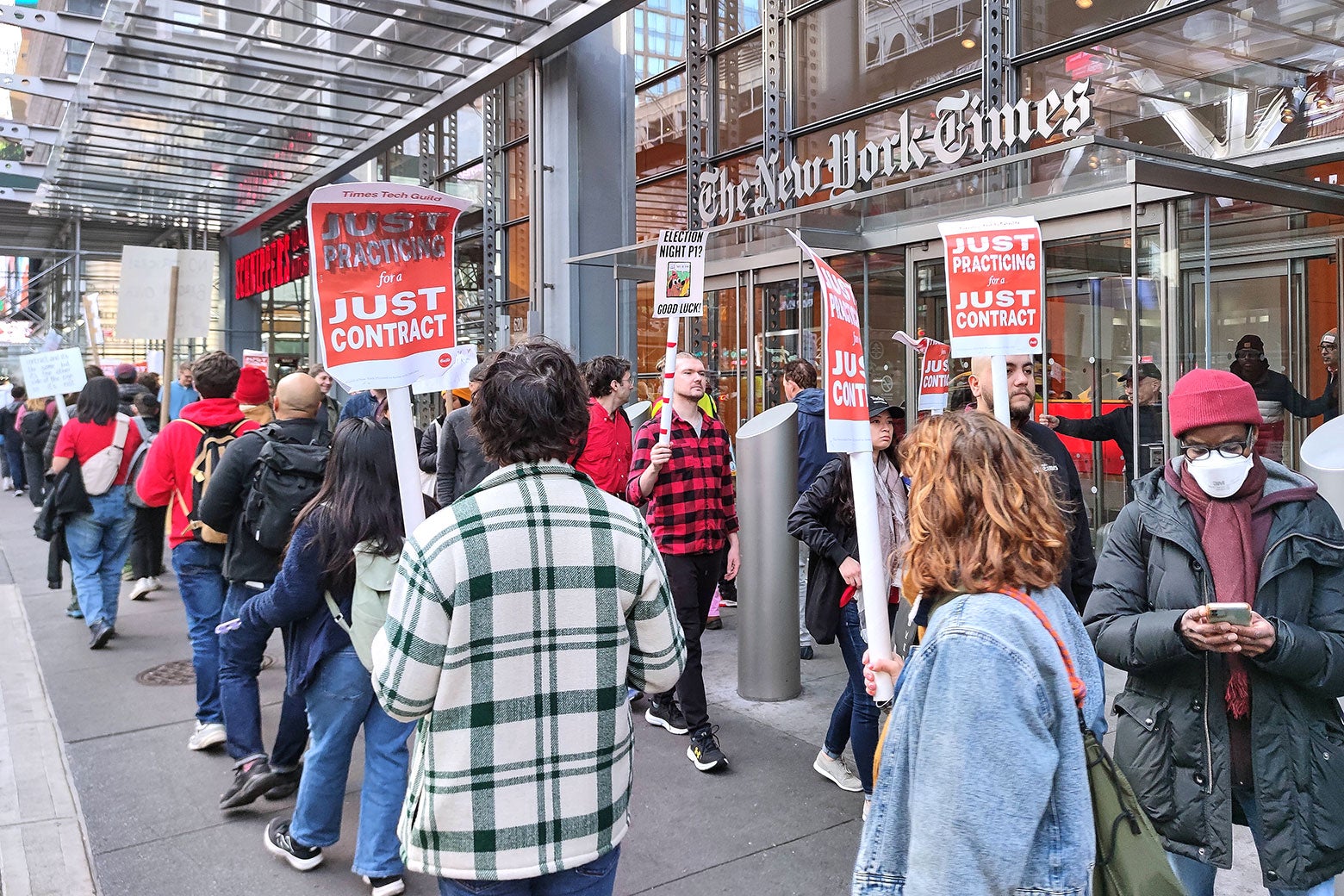The New York Times’ Worst Nightmare Is Happening Now
They’re the country’s largest tech workers union. They ensure that the most influential newspaper in the world can function. And now, just in time for Election Day, they’re on strike.

The 600 staffers organized with the New York Times Tech Guild—who program essential functions like push alerts, live blogs, homepage designs, and the games—officially walked off the job Monday, and the effect on their employer’s website is already apparent.
The Times’ iconic Needle, a staple of every major election since 2016, may be too buggy to function, according to pollster Nate Cohn. Subscribers are expressing solidarity online by sharing screenshots of their now-broken Wordle/Spelling Bee/crossword streaks, following a guild request for users to boycott the NYT Games app. And the front-page TikTok-style vertical-video promotion of “Our reporters on what to expect” did not last past Monday night.
As for why the Times’ tech workers are acting to upend their own website on the most important news day of the year, this moment has actually been years in the making. Back in 2021, when these employees first announced they were forming a union of their own (one separate from the respective editorial unions that represent the NYT newsroom and its Wirecutter subsidiary), the paper’s leadership refused to recognize the unit, kicking the matter up to the National Labor Relations Board—which soon filed its own complaint against Times management for violating federal labor law by telling other newsroom employees not to express any support for the tech organizers.
The Tech Guild’s union was officially certified in March 2022, under the aegis of the NewsGuild of New York, which also represents the Times’ other unions (both of which separately expressed their solidarity). But the contract-negotiation process was grueling, and various sticking points over issues like just-cause protections and return-to-office mandates fueled even more NLRB disputes and walkouts in protest. (The RTO fight is of particular importance, in light of the fact that many of the organized employees work remotely and did not wish to be forced to move to New York City.)
This September, with those disagreements still on the table, the Tech Guild approved a strike-authorization vote—and right away, as a guild spokesperson told the Nation’s Thomas Birmingham, Times management began meeting with individual members to offer them an HR-approved means of continuing their work during Election Day, if they wished not to participate in the strike. Management dispatched a follow-up memo last month to reiterate this point, even as NYT executives received statements of solidarity from the unions representing the newsroom and Wirecutter. Despite some grumbles from individual reporters, such statements made clear that internal momentum was on the Tech Guild’s side, for its core demands of just-cause protections, remote-work flexibility, and fixes to the inequitable pay structures that undercompensated the union’s nonmale, nonwhite members.
“This decision by the company to force them to strike for what are very reasonable demands is, frankly, a failure of institutional leadership,” Andrea Zagata, an NYT senior staff editor for news design, told me in an interview. “There’s so much stuff in our contract that Tech is not close to having, and it’s very disappointing.”
Institutional leadership doesn’t view it that way, of course. In an internal email sent on Monday, New York Times owner A.G. Sulzberger wrote that “it is troubling that the Tech Guild would try to block this public service at such a consequential moment for our country,” that he is “sorry that this action by the Tech Guild was designed to put all of this work at risk,” and that the company had “robust plans in place to ensure that our essential journalism reaches our readers.” (In response, Times business reporter Stacy Cowley told the Washington Post’s Laura Wagner, “These plans have not been communicated to journalists in the newsroom.”)
As the Tech Guild presses on with what NewsGuild President Jon Schleuss refers to as “the largest tech worker strike in U.S. history,” and as Times newsroom staffers remind one another that they have the right per their own contract’s terms to refuse to take on any tasks that overlap with the tech strikers’ duties, outside detractors have swooped in. The CEO of the generative-A.I. app Perplexity—which received a cease-and-desist letter from the Times last month asking it to stop using NYT prose for data-training purposes—offered to help the paper ensure that “essential coverage is available to all during the election” and requested that Sulzberger message him. Other writers on X seized upon a 2-month-old Semafor report about certain guild requests, including scented-product bans, grief leave for dead pets, and trigger warnings in internal meetings, to imply that these were the reasons behind the tech workers’ strike—even though, other Times employees noted, those items were “mischaracterized” in the report and have anyway not been on the table for a long time.
“That’s a straw man,” Zagata insisted. “Some people are taking the bait and are playing right into the hands of management. But the guild is not on strike over scented products, I can tell you that.”
In the meantime, as Sulzberger himself noted, the strike is likely to continue through the election, and the workers have been shouted out by fellow union ringleaders, like Association of Flight Attendants President Sara Nelson, as well as local politicians, like NYC Council Speaker Adrienne Adams and New York state Sen. Jessica Ramos. The Tech Guild’s strike fund has garnered over $100,000 in donations. And the newspaper itself remains profitable and retains a healthy subscription base. What it doesn’t have, however, is a needle—or any sense of what else may break this week as the Tech Guild marches on.

Comments are closed.